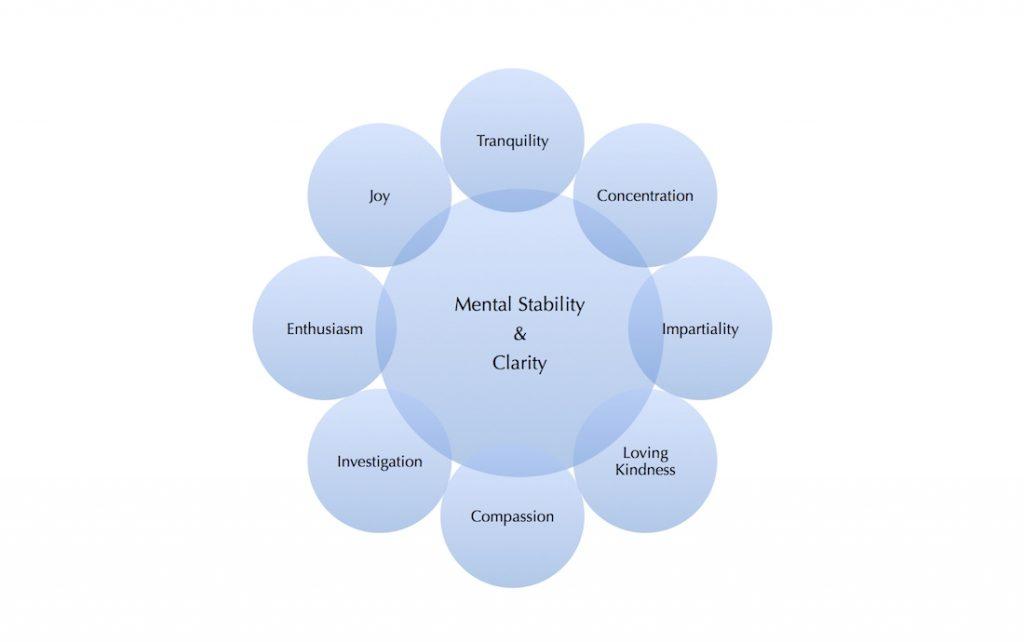From diegohangartner.org
For more than three decades, I have researched and explored the mind and consciousness. My investigations have included pharmaceutical lab work with mind-aging substances and their effects, as well as addiction in individuals. Drawing on many years of Buddhist Studies in the East in the presence of great masters and yogis, I worked at the forefront of the intersection between science and contemplative practices within the Mind and Life Institute. From this multidisciplinary understanding of practices—how they work, and what (desired and undesired) effects they can have—I developed a methodology to transmit the tools that support and facilitate mental balance. For several practical reasons, I ended up calling this method the “Wheel of Mental Balance.”
One of the most persistent and frustrating issues facing us today is that we lack mental well-being, often feeling restless, anxious, and inattentive. These conditions are increasing and are shared by many. We have become very skilled at being distracted, and seldom do we consider, nor do we understand, the mechanisms that lead to such a lack of focus. Our mental world is under great pressure, at a high cost to us both as individuals and as a society, and in economic terms as well as ecologic. We are beset by stress, sickness, absenteeism, depression, low self-esteem, suicidal thoughts, ADHD, drug abuse, and the need for activity in order to compensate for an inner void.
So how is it that we are exhausted, stressed, and lacking mental balance even when our basic, physical needs are met? What if we were able to regain our mental stability and to focus on what really matters?
Over the last 10 years, a growing body of evidence has emerged from the highest level of scientific research that confirms the mental and physical benefits of mind training, in other words, meditation. Most research has centered on the practice of mindfulness. The clinical sciences in particular have been drawn to the advantages of this interdisciplinary, non-religious approach, as some forms of meditation have proven helpful in reducing anxiety, addiction, depression, restlessness, and stress.
While in the past meditation practices were often considered only borderline acceptable, this was mostly because their purpose and methods were not well understood. In more recent years, a great deal of scientific research and literature has been published, contributing to a change in perception regarding the values and benefits these practices can have. Accordingly, mindfulness-based methods and forms of therapy are becoming more widely accepted and applied. However, as many people working in this area readily acknowledge, mindfulness practice alone is not enough to build and support mental balance; it is just the first step. Many mindfulness-based program participants often ask for more transformative practices that can help them deepen their practice. The Wheel of Mental Balance addresses this need in a very pragmatic and profound way. Based on traditional meditation practices, it is also infused with insights from modern neuroscientific and clinical research.
The Wheel of Mental Balance
The main purpose of the Wheel of Mental Balance is to develop mental serenity and resilience in a modern context. It combines techniques and processes found in classical Buddhist texts, extracting the values of practical application without losing the richness of the original material.
Negative emotions and experiences are very closely related to one’s mental state and attitude. From the emerging scientific evidence and the words of the wise, it is clear that much depends on one’s attitude. As Viktor Frankl, the Austrian psychoanalyst and Holocaust survivor of the camps of Auschwitz and Dachau, succinctly wrote, “The last of human freedoms [is] the ability to choose one’s attitude in any given set of circumstances.”*
According to the leading neuroscientist Richard Davidson, modern research has identified four mental components of well-being: resilience and the capacity to recover from adversity; positive outlook; generosity and the ability to direct and redirect attention at will.** Methods provided within the Wheel of Mental Balance offer ways to strengthen these four elements; it links the original use of mindfulness practice in the Buddhist teachings to a larger, secular framework with the aim of progressing towards a deeper sense of purpose, mental balance, and an awakening to the beauty and magic of life.

The Wheel of Mental Balance © Diego Hangartner
Structure
Based on a coherent architecture, the program incorporates well-honed tools and expands the scope of the application of mindfulness to include critical and important factors of the mental world—investigation, enthusiasm, joy, tranquility, concentration, impartiality, loving-kindness, compassion , ethics, and wisdom. It features practices from and aspects of early Buddhist meditation, Mahayana practices, and neuroscientific and psychological insights, leading to mental stability, clarity, and inner tranquility. Practices include: shamatha, or “calm-abiding,” in which the mind is concentrated on an object; the Four Applications of Mindfulness***; the Four Immeasurables (Brahmaviharas)**** and tonglen, or “exchanging oneself with others”; and practices related to the nature of mind.
The whole program is designed around three central domains of psychology: conation, cognition, and affection. From a Buddhist perspective, it can be said that for mental flourishing, three dimensions of one’s mental life and activity need to work in balance: attention, perception and knowledge, and feelings. In order to foster mental balance, each of these three areas needs to be explored, understood, and developed. The program is structured so that it addresses each domain with separate exercises, helping us to realize when our mental process is out of equilibrium and guiding us towards balance.
The Wheel’s spokes are the above-mentioned factors of the mental world (investigation, enthusiasm, and so on), and these are centered around the hub of mental stability and clarity. These different factors (spokes) of the mental world are, for obvious reasons, taught and introduced in sequence. However, one should not think that these positive qualities are inseparable; by practicing each aspect separately, it will become evident how these mutually beneficial factors of the mental world are cultivated.
If we aspire to a fulfilling mental life, we cannot disregard these three dimensions. Accordingly, if we wish to balance our mind, we need to understand all of these mental qualities and their interdependence. When the mental dynamics are understood experientially, and not just theoretically, the seeds for positive qualities such as loving-kindness and compassion can be properly planted, nurtured, and matured.
The practices initiated by the historical Buddha, Shakyamuni, included several methods to penetrate and explore these questions. While this led to the development of many philosophical systems, several fundamental elements are present in each:
1. The mind can be trained, and through specific types of training, can become more stable and clear (attention process).
2. Clarity and stability can be applied to investigate the process of how we perceive, and how we interpret those perceptions and create ideas and concepts. It is these biased interpretations that cause suffering and mental dissatisfaction (perception and cognition process).
3. By identifying causes and their corresponding results, the torrent of causes and effects can be changed and, more specifically, the source of mental dissatisfaction can be uprooted through the cultivation of positive mental qualities and emotions like compassion and loving-kindness (affective process ).
The Buddha’s teachings on the Four Noble Truths***** have been relevant in the past, and are equally pertinent in the present for us to understand and create mental well-being—the Wheel of Mental Balance is a contemporary, non-secular , and practical interpretation of the profundity of the Dharma. I have been privileged to teach the Wheel in many different settings: in retreats, in courses over a few months, and in companies. It is being taught to private students as well as to professionals such as business people, entrepreneurs, health professionals, and teachers, and to patients, too. One of the recurring endorsements given by students has been how they have found the program beneficial for their personal development towards clarity, stability of mind, inner peace, and joy.
* Viktor E. Frankl, Man’s Search for Meaning, Beacon Press, Boston, 1959 (1946)
** Richie Davidson, Mind and Life Conference XXX, Sera Monastery, December 2015
*** The Four Applications of Mindfulness: Mindfulness of the Body; of feelings; of the Mind; and of the Contents of the Mind
**** The Four Immeasurables: Loving-kindness or Benevolence; compassion; Empathetic Joy; impartiality
***** The Four Noble Truths: The Truth of Suffering; the truth of causation; the truth of cessation; and the Truth of the Path
see more
The Wheel of Mental Balance
Diego Hangartner completed his studies in pharmacology at the Federal Institute of Technology, (ETH Zurich), specializing in psychopharmacology and addiction. Following his work with an aid project in Nepal, he lived in Dharamsala, India, for 11 years, learned Tibetan, and studied for 7 years at the Institute of Buddhist Dialectics in the Tibetan language. He has completed several silent meditation retreats, worked as an interpreter, translating Tibetan into many languages, and published several books. On returning to Europe in 2003, he taught widely, organized large events with His Holiness the Dalai Lama, such as the visits of HH to Switzerland (2005) and Hamburg (2007), and participated in research aimed at exploring the benefits of meditation as a long-term practitioner. He is associated with and worked for the Mind and Life Institute from the 1990s, as the Mind and Life COO from 2008–12 in the US, as co-founder of Mind and Life Europe, and as its director until 2014.
In 2015, Diego decided to concentrate on his main passion of teaching content and tools that build mental balance. He founded the Institute of Secular Ethics and Mental Balance (ISEMB), an interdisciplinary initiative to develop and provide tools and programs that foster mental balance. Besides acting as the ISEMB’s founding director, he is also the institute’s principal teacher.
Did you miss our previous article...
https://yogameditationdaily.com/meditation-retreats/city-files-injunction-to-stop-meditation-retreats






